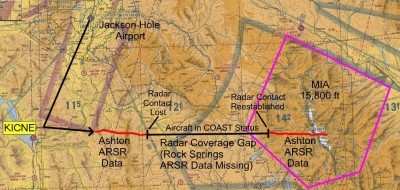Fri, Apr 22, 2011
Follows 2010 Fatal Accident In Wyoming
An accident in Wyoming in 2010 has prompted the NTSB to
recommend to the FAA that it make changes in instrument departure
procedures in the Jackson Hole, Wyoming area.

N201HF Route Of Flight
On October 25, 2010, about 1352 mountain daylight time,1 a
Mooney M20J airplane, N201HF, collided with mountainous terrain
near Lander, Wyoming.2 The pilot and three passengers were fatally
injured, and the airplane sustained substantial damage. The
airplane was operated under the provisions of 14 Code of Federal
Regulations (CFR) Part 91 as a personal flight. Instrument
meteorological conditions likely prevailed at the time of the
accident,3 which operated on an instrument flight rules (IFR)
flight plan to Pierre Regional Airport (PIR), Pierre, South Dakota.
The flight originated from Jackson Hole Airport (JAC), Jackson
Hole, Wyoming, at 1305.
After review of the air traffic control (ATC) services provided
to the pilot by Jackson Hole Air Traffic Control Tower and Salt
Lake City Air Route Traffic Control Center (Salt Lake Center), the
National Transportation Safety Board (NTSB) is concerned that the
published IFR departure procedures available to aircraft departing
JAC may be inadequate. In addition, the NTSB believes that the en
route automation modernization (ERAM) ATC software in use at Salt
Lake Center needs improvement to ensure that IFR aircraft are
afforded necessary en route minimum safe altitude warning (E-MSAW)
protection.

The NTSB recommends that the FAA Establish Standard Instrument
Departure procedures that provide transition routes and minimum
instrument flight rules altitude information for aircraft cleared
over commonly used navigational fixes from Jackson Hole Airport and
similarly situated airports. It further suggests that the agency
modify en route automation modernization software such that en
route minimum safe altitude warning alerts are provided for
aircraft in coast track status that are receiving automatic
position updates.
Finally, the NTSB says the FAA should modify en route automation
modernization software such that cautionary warnings are provided
to controllers when an aircraft is predicted to enter a minimum
instrument flight rules altitude (MIA) polygon below the MIA.
More News
Aviation Governance Secured...At Least For a While The National Business Aviation Association similarly applauded the passage of the FAA's recent reauthorization, contentedly recou>[...]
Emphasis On Growing The Future of Aviation Through Concentration on 'AFFORDABLE FLYERS' It's been a number of years since the Latest Edition of Jim Campbell's HUGE SportPlane Resou>[...]
Amazilia Aerospace GmbH, Develops Digital Flight Control, Flight Guidance And Vehicle Management Systems Textron eAviation has acquired substantially all the assets of Amazilia Aer>[...]
Honeywell's Primus Brings New Tools and Niceties for Hawker Operators Hawker 4000 business jet operators have a new installation on the table, now that the FAA has granted an STC f>[...]
Company Celebrates Niche-but-Important Advancement in Industry Standards Echodyne has announced full integration of its proprietary 'EchoFlight' radar into the e American Aerospace>[...]
 Bolen Gives Congress a Rare Thumbs-Up
Bolen Gives Congress a Rare Thumbs-Up The SportPlane Resource Guide RETURNS!!!!
The SportPlane Resource Guide RETURNS!!!! Buying Sprees Continue: Textron eAviation Takes On Amazilia Aerospace
Buying Sprees Continue: Textron eAviation Takes On Amazilia Aerospace Hawker 4000 Bizjets Gain Nav System, Data Link STC
Hawker 4000 Bizjets Gain Nav System, Data Link STC Echodyne Gets BVLOS Waiver for AiRanger Aircraft
Echodyne Gets BVLOS Waiver for AiRanger Aircraft




